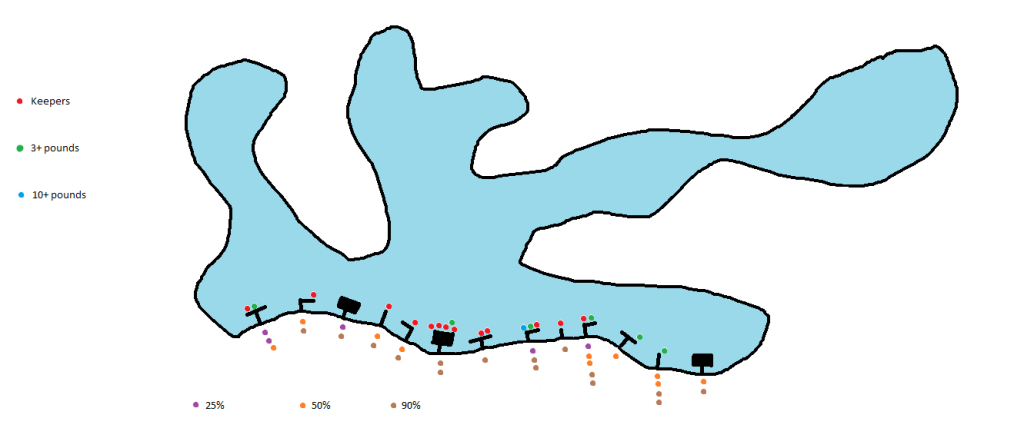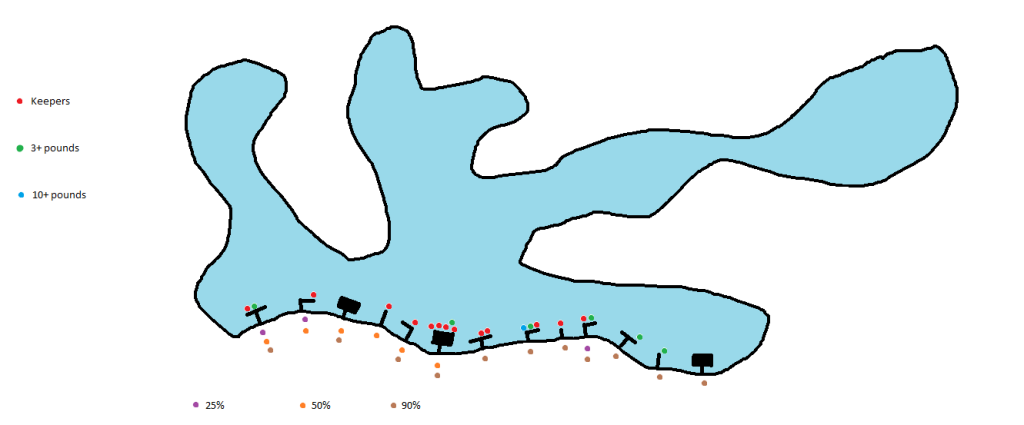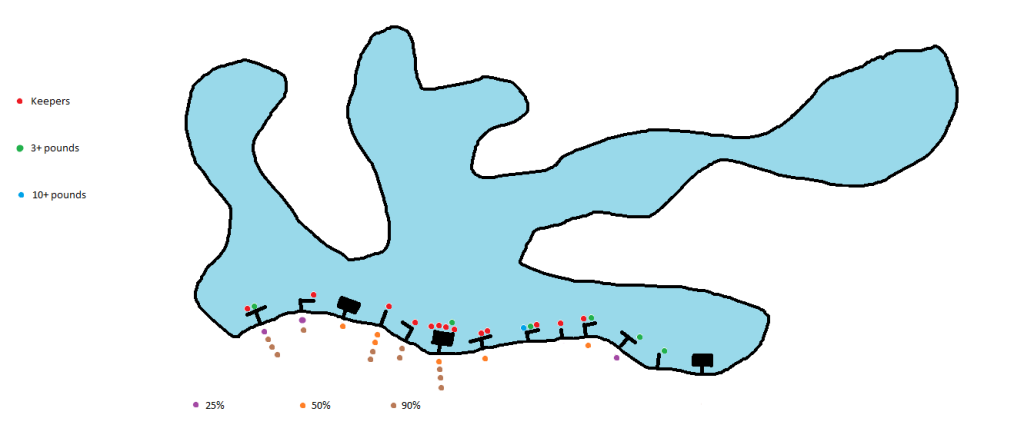Well, it seems like my last blog post has generated quite a bit of interest and discussion. For some guys, the ideas in that post are certainly nothing new, but for others, it was pretty eye-opening. Last night I actually had the idea to perhaps make an illustration or two to show the idea behind what I was describing with my casting accuracy scenario, so I went ahead and threw one together this morning. Now obviously, there are way more factors that go into something like this in a real life situation, and there are obviously problems with this scenario… but the basic principles and idea behind the whole thing is still applicable. Let’s consider our scenario here.
You’ve decided to fish a shoreline with 13 docks on it. There are fish scattered throughout the docks and the fish are represented by colored dots next to the docks in the water. For this, we are going to look at just one factor: lure presentation. In order to draw a strike from a fish, you need to make the right lure presentation. Now, you only have enough time to make one cast at each dock, so basically you have enough time to make 13 casts. For our first situation, we’re going to say that you only make one cast at each dock. Here’s the illustration:
So what happens if you are only able to make the correct lure presentation an average of 25% of your casts? If you only have time to make one cast at each of the 13 docks, then that means you will only make the right presentation at 3 of the docks (13 x .25 = 3.25). I used a random number selector in order to randomly select 3 of the 13 docks. The docks you made an accurate presentation to are represented by a purple dot on the shoreline below the dock. You managed to catch 3 fish. Not bad. Also, right now all we are concerned with is numbers of fish, not size.
Ok, so what happens if we increase (double) your ability to make the correct presentation to 50% of the time? That means you will be able to make the right presentation at 6 docks (13 x .5 = 6.5). Once again, I used a random number selector to select 6 docks. You caught 5 fish this time. Not bad at all. Certainly an increase from the 3 fish you caught before, and shoot, if you were in a tournament, you’ve got a limit this time!
Let’s step it up another notch and increase our ability to make the correct presentation to 90% of the time. That means we will make the correct presentation to 11 of the 13 docks (13 x .9 = 11.7). Count ’em up. Boom, we caught 9 fish this time. That’s three times as many fish as we caught when we were only making the correct presentation 25% of the time. You get the idea…
Ok, now, let’s look at things just a little bit differently this time. Let’s stick with the idea that you only have time to make 13 casts, however, if you catch a fish on a certain dock, you are going to make another cast at it to see if you can catch another one. And just for fun, let’s randomly switch our percentage dots around on the shoreline.
This one took a lot more brain power to think through. Ha! Ok, so to be clear, a percentage dot on the shore indicates that you made an accurate presentation for one cast. Also, for this scenario, we are going to assume that when we start fishing, we start at the dock on the left and move to the next dock to the right when we make a cast that fails to yield a fish.
Let’s look at how many fish we catch if we are successful at making an accurate presentation for 3 of our 13 casts (25%). I’ll walk you through it because this one gets a little tricky. On the first dock, we make an accurate presentation on our first cast and catch a fish, so we cast at the dock again. However, the next cast is not a correct presentation, so we fail to catch a fish and move to the next dock. Notice, there is a 2nd fish at the first dock that can be caught, but since our second cast didn’t have the correct lure presentation, we didn’t catch it, so we moved on. At the next dock, we make an accurate presentation, catch a fish, and cast at the dock again. Once again, our second cast to the dock is an inaccurate presentation, however, this time there’s no fish there to be caught, so it doesn’t hurt us that bad. As we move on, we fail to make an accurate presentation on docks 3-10. That brings our total up to 12 casts. We have time for one more cast, and we make the last one count with an accurate presentation on dock 11 and catch a fish. Congrats, you caught 3 fish while having a 25% correct lure presentation rate.
Ok, hopefully you get the idea of how this scenario works after walking through the first one. Let’s look and see what we catch when we are able to present the lure correctly 50% of the time. Once again, start at the dock on the left. The orange dots represent the times we were able to make the correct presentation. Docks 1 and 2 we fail to make correct presentations. Dock 3, we make the correct presentation, but unfortunately there isn’t a fish there. Dock 4, correct presentation, catch a fish, make another correct presentation, but no more fish to catch, so we move on. Dock 5, incorrect presentation, move on. Dock 6, correct presentation, catch a fish, make another cast, but it’s not a correct presentation, no fish, move on. Bummer, there’s a bunch of fish on dock 6. Oh well. Blah, blah, blah…. keep moving on and when all is said and done we manage to catch 4 fish with our 50% correct lure presentation rate. That’s just one more fish than our 25% rate this time, but hey, that’s still one more fish.
Moving on to 90%. Hopefully you can walk through it in your head after the first couple of examples, so I’ll skip the walk through. When we bump it up to 90%, we catch 8 fish. I’d say 8 fish is significantly more than the 3 we caught with only a 25% correct lure presentation rate.
Let’s create a bit of a new scenario this time. What if you don’t really care about catching as many fish as possible?Let’s say that you are fishing in a tournament. You are only looking for 5 fish and you are thinking you need to catch 5 fish all over 3 pounds in order to win, so you tie on a jig and start fishing these docks. We’ll get rid of our time limitations for this scenario and say it’s the beginning of our day, so we have plenty of time to fish these 13 docks no problem. Once again though, we will say that if we catch a fish, we are going to make another cast at the dock. We’re also going to randomize it slightly differently. Our correct lure presentation rates are an average throughout the whole tournament day, so these 13 docks are just a snapshot of our day. We are going to say that on each cast, we have either a 25, 50, or 90% chance of making the correct presentation, so we likely won’t be looking at the same numbers of dots as we did in our other scenarios. Here’s what the illustration ends up looking like:
Now again, for this one, the only fish dots we are looking at are the GREEN and BLUE dots since they are fish that are over 3 pounds and are more likely to eat that nice big jig we are using. We will assume the smaller red dot fish don’t want anything to do with our jig.
Ok, 25% correct presentation rate. Again, each cast we have a 25% chance of getting the right presentation, and if we catch a fish, we are casting at the dock again… no fish and we go to the next dock. Dock 1, accurate presentation, catch a 3+ pounder, make another accurate presentation, but no more 3 pounders to catch. Dock 2, bad presentation, move on. Dock 3, accurate presentation, but no fish. Blah, blah, blah… what do we end up with? We caught 3 fish all over 3 pounds. Decent. What happens with 50% and 90%?
50% = 4 bass over 3 pounds
90% = 5 bass over 3 pounds… Plus the 10+ pound kicker! You win the tournament!
See how that works? Cool huh?
Last scenario I’m gonna throw out there. This is basically the same scenario as the tournament deal, but instead of looking for 3+ pounders, we are a big bass hunter. All we are interested in is getting that GIANT. We are headed out throwing nothing but giant swimbaits all day looking for Big Bertha. She’s that lone blue dot on dock 8. Let’s see what happens…
25% = No Big Bertha
50% = No Big Bertha
90% = BOOM! Got her! And even made another cast to see if she had a sister living with her on the dock. 🙂
Now, is it possible for the person who is only able to impart the right action on their swimbait 25% of the time to catch Big Bertha? Absolutely. And is it possible for the dude that can work that bait right 90% of the time to miss her? Yup, that’s possible too. It happens in real life sometimes. We are just looking at odds here, and odds are… the dude with the 90% rate is much more likely to catch Bertha than the other guys. And this time, that’s indeed how it happened.
Again, obviously real life is a bit more complicated than this. There are so many factors that go into whether or not a fish will bite and whether or not you’ll even manage to land that fish. But no matter how many factors you throw into it, the idea remains the same. Do everything you can to maximize your odds of success. As I mentioned in my previous blog post, the two most important factors in my opinion are 1) location and 2) presentation. If you didn’t read my previous post, make sure to read it to get more information on that.



[…] ***After writing this post, I got a little bug in my ear about making another post with some illustrations and various scenarios to go with it. Check ’em out here.*** […]